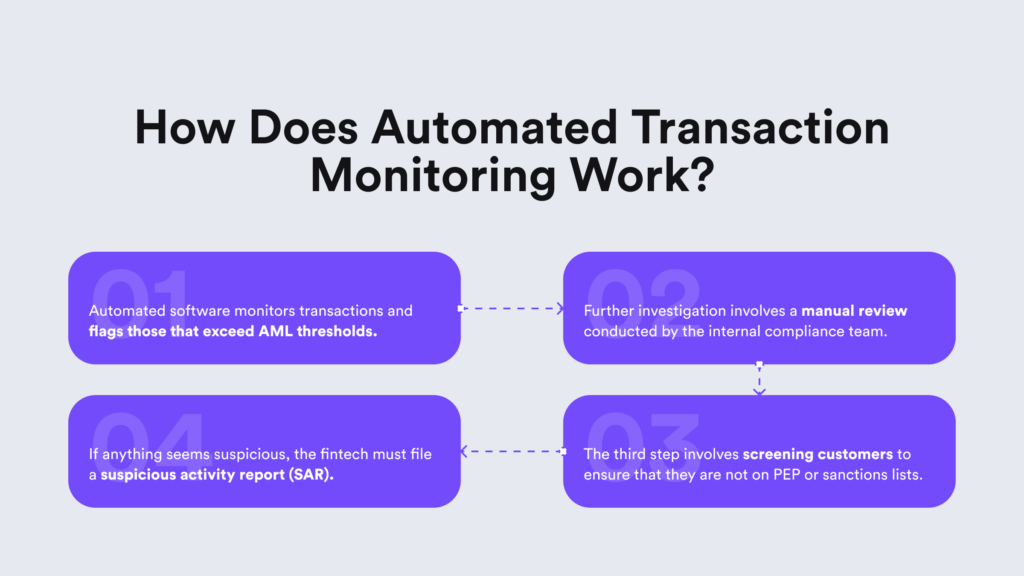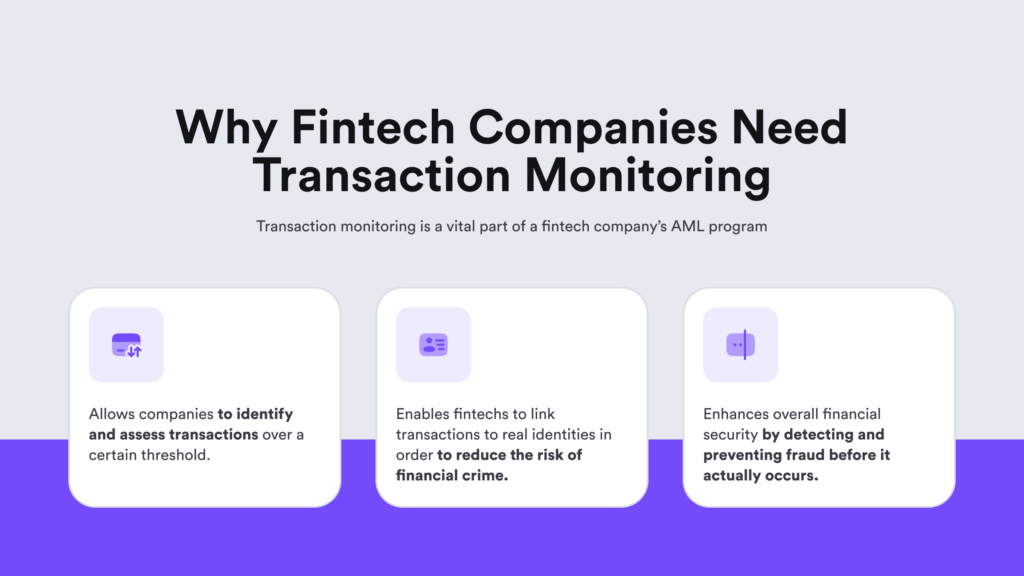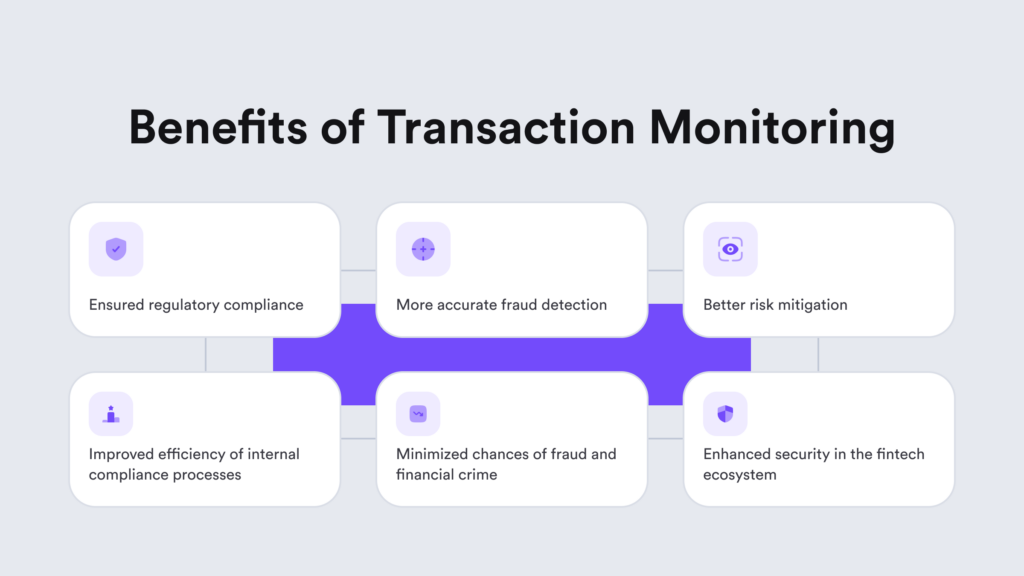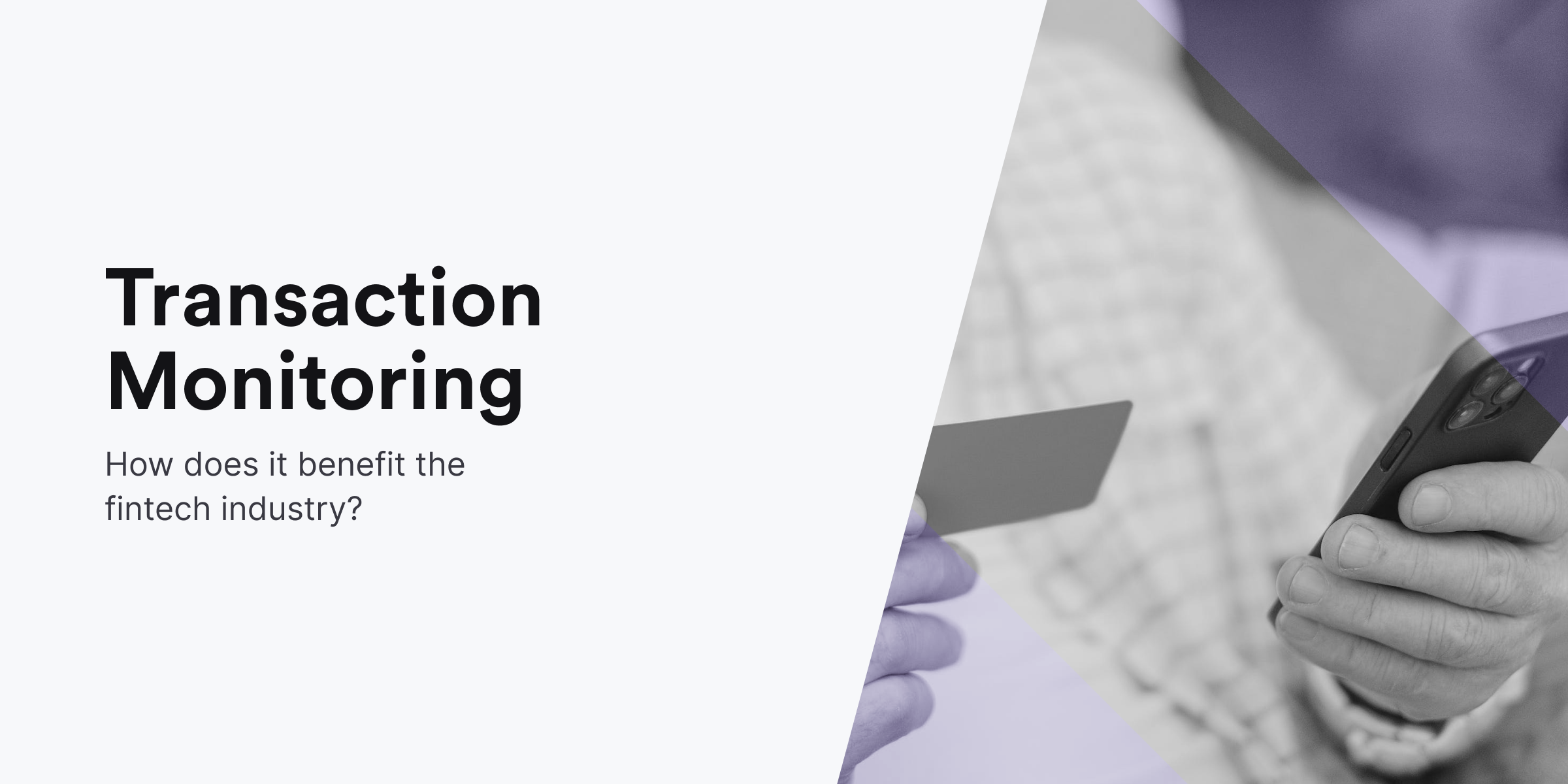Transfers, deposits, withdrawals, or any other customer transactions can be used to launder illicit funds. And the worst part is that illicit funds can be used pretty much anywhere – from gambling platforms to payments for a mortgage. For this reason, all financial institutions and financial service providers, including fintech companies, are obliged to monitor customer transactions to detect financial crimes.
Transaction monitoring not only serves as one of the key tools to identify suspicious activity but also analyzes current and historical customer data, giving companies a better look into their customers and their risk profiles.
Despite that, this process is more complex than many assume, especially in today’s geopolitical landscape, where obliged entities must deal with different sanctioned regimes, making sure they do not run a green light on transfers from sanctioned regions, for example. This is also a part of transaction monitoring.
Keep reading to find out more about transaction monitoring and AML compliance requirements for the fintech industry.
What is Transaction Monitoring in the Context of Fintech?
Transaction monitoring is a practice that is designed to track and screen customer transactions, for example, deposits, transfers, or withdrawals, for fintech companies to detect potential illegal activity, such as money laundering or terrorist financing.
This process aims to closely monitor customer transactions in order to identify and prevent potential instances of money laundering or other financial crimes. Transaction monitoring is also part of AML compliance obligations that are set by regulatory authorities. These rules are standard practices that fintech companies and other financial institutions must follow and implement to stay compliant.
During transaction monitoring, suspicious transactions are flagged. Fintech companies then need to follow further investigations to determine their legitimacy. This is why ongoing transaction monitoring is vital in order to identify potential issues and prevent unwitting involvement in money laundering at any stage of the business relationship with the customer.
The History of the Transaction Monitoring Process
The origins of monitoring transactions for potential money laundering activities go back to the 1980s. This was a time when people started to focus more on combating financial crime through standardized, established measures that were specifically designed to prevent the illicit use of the financial system.
However, fast-forward to the 2000s, the sophistication of transaction monitoring reached a whole new level, considering the increasing use of machine learning and artificial intelligence (AI). These new technologies helped fintech companies and other money services businesses (MSBs) to handle large datasets and identify suspicious transactions.
Today, the fintech industry sees transaction monitoring as the primary component for ensuring compliance with AML rules, which require fintech to:
- Scrutinize transactions in order to detect and report suspicious activities to relevant authorities.
- Implement a proper transaction monitoring process, often through automated AML software, in order to meet regulatory requirements.
Typically, even though many fintech companies use some sort of RegTech software for transaction monitoring, the human touch is inevitable. Automatically flagged transactions are often checked manually by internal compliance teams. They are responsible for assessing the customer’s transaction history, the countries involved, and the overall customer risk profile.
How Does Automated Transaction Monitoring Work in Fintech?
In fintech, automated transaction monitoring processes work by screening and reviewing transactions in real-time. Fintechs typically follow this step-by-step structure of the transaction monitoring process, which includes:
- Establishing the customer’s risk profile
- Conducting ongoing monitoring
- Detecting anomalies
- Investigating particular suspicious activity
- Reporting such activity to the authorities

This streamlined approach allows for flagging suspicious transactions for manual review. In other words, after detecting illicit activities, the automated transaction monitoring process issues an alert, prompting the compliance team to conduct a follow-up assessment.
By far, the key benefit of why fintechs use automation is to minimize human error and identify criminal activities on a broader scale. At the same time, automated solutions enable fintech businesses to handle more transactions at a much faster rate. So, through AML automation, fintechs can achieve greater efficiency, accuracy, and regulatory compliance.
The Importance of Transaction Monitoring in AML
Transaction monitoring is important for fintech companies because it serves the purpose of detecting suspicious activities, including fraud, money laundering, terrorist financing, and other financial crimes.
However, even fintech companies implement transaction monitoring primarily due to their vulnerability to money laundering, they are also obliged to comply with AML requirements imposed by authorities.

Above all, using transaction monitoring in AML compliance is important for fintech companies that want to:
- Prevent unlawful activities, such as allowing money launderers onto their platform.
- Maintaining a positive reputation and trust among their customers.
- Avoiding non-compliance and the huge fines that come with it.
Fintech companies ultimately share one trait, which is technology and innovation. The level of connectivity in the fintech industry solutions not only facilitates innovation but also serves as a means to protect products, customers, and the broader financial chain. That’s why integrating AML processes, such as transaction monitoring, is crucial for fintech businesses, with increasing regulatory scrutiny demanding robust AML measures.
In addition to transaction monitoring, AML program requirements consist of scrutinizing transactions and customers against sanction lists, politically exposed persons (PEPs), and global watchlists associated with terrorism and crime.
Related: PEPs and Sanctions Checks Explained
What is a Threshold in Transaction Monitoring?
Several factors can breach a threshold during transaction monitoring. Thresholds serve as cutoff points. Once the system is triggered, the relevant compliance team member is responsible for investigating the AML red flag, which is an alert for an unusual activity or a suspicious transaction pattern.
In general, transaction all transaction monitoring thresholds are designed to help fintech companies:
- Establish connections between transactions and identities.
- Detect suspiciously large money movements.
- Maintain transaction records for submitting Suspicious Activity Reports (SARs).
Naturally, money laundering and terrorist financing pose threats to the stability and security of the whole financial system, putting fintech companies at risk of being blacklisted by external institutions. So, if customers do not meet the risk threshold, they undergo a low-friction process determined by the fintech company’s preferences and mandated requirements.
Such crimes threaten the stability and security of the entire financial system, exposing fintech companies to the risk of being blacklisted by external institutions. To address this, government agencies set AML check thresholds, providing fintech companies with a framework to define their monitoring criteria.
Examples of Potential AML Risks During Transaction Monitoring
To prevent the risk of money laundering, fintech companies should fulfill AML obligations in the regions they operate. This means creating an AML compliance program is crucial, as well as identifying potential risks to avoid unwanted consequences.
For example, if a customer engages in a substantial volume of transactions spanning multiple countries within a short timeframe, this could be a sign of potential money laundering. Similarly, large cash deposits or frequent withdrawals within a short time frame can trigger suspicions about the underlying intent of these transactions.
In general, there are a few key risk factors that fintech companies must consider when conducting transaction monitoring:
- The level of diversity of the operations being conducted in the financial sector.
- The scale, nature, and complexity of the company.
- The product, activity, and customer risk profile.
- The size and volume of transactions.
- The company’s distribution channels.
- The degree of extent to which the fintech company engages with intermediaries and third parties.
- The level of risk associated with each area of the fintech industry.
Signs of Potential Crimes in Fintech According to the FATF
The Financial Action Task Force (FATF), a global money laundering and terrorist financing watchdog, has a list of recommended signals that should indicate higher scrutiny when conducting transaction monitoring.
It includes the following:
- Changes in customer behavior
- Cross-border transactions
- The usage of foreign currency
- Suspicious cash transactions
- Unusual payment methods
- Engagement with virtual currencies
- Inconsistent payments
- Suspicious transaction details
- Transactions involving unusual amounts
- High-risk counterparties
- Swift movement of funds
- Operations with multiple products
- Suspicious assets
During transaction monitoring, fintech companies should consider instances such as wire transfers from other countries followed by multiple withdrawals or multiple card payments from the same customer on different dates as potential signs of money laundering.
Related: AML Red Flags — Complete Breakdown
Other AML Evasion Techniques
Ultimately, the swift nature of the fintech industry’s cross-border transactions creates almost an ideal avenue for money laundering and terrorist financing. However, it’s safe to say that these activities target fintech companies with lower levels of security, including transaction monitoring, ID verification, watchlist screening, etc.
To stay informed about money laundering, it’s important for fintechs to know the key AML evasion techniques. Here are some examples that provide standard guidelines for different industries:
- Shell companies and trusts. Criminals use trusts and shell companies to mask their illicit funds. They often lack genuine business operations and only create the illusion of legitimate transactions. That’s why it is challenging for authorities to trace funds back to their source. Similarly, bad actors use trusts to create separation between beneficiaries and illicit assets. Since trusts offer anonymity, especially when established in jurisdictions with strong secrecy laws, criminals use them as a tool to launder money.
- Gambling and casino laundering. Individuals engaging in money laundering through gambling platforms often use multiple accounts to transfer funds across various platforms. This is also referred to as “gnoming” or the practice of using multiple accounts to assist one player in winning. In general, criminals leverage this dynamic nature of games to legitimize their ill-gotten gains. For example, another popular method for evading AML thresholds is betting substantial sums on low-risk games like blackjack. Later, they convert their chips into clean banknotes, eliminating any suspicion.
- Smurfing. It’s another money laundering technique where criminals divide large sums of cash into numerous small transactions in order to avoid reporting detection. However, to combat smurfing, regulatory authorities have defined specific reporting thresholds. For example, the PATRIOT Act broadened the powers of law enforcement to counter money laundering by instituting reporting requirements for financial transactions, including deposits, withdrawals, or currency exchanges, exceeding $10,000.
Benefits of Risk-Based Transaction Monitoring in Fintech
Implementing a risk-based approach in the transaction monitoring process is an important part of AML compliance. It involves categorizing customers based on their risk profiles and information collected during the Know Your Customer (KYC) process.
For example, certain transaction types, such as cross-border or correspondent banking transactions, are classified as high-risk. During transaction monitoring, fintech companies should apply more stringent transaction monitoring rules for high-risk customers as well, such as the mentioned PEPs, customers from high-risk countries or jurisdictions, as well as entities like casinos and transactions associated with non-profit organizations, which are more susceptible to money laundering.
Here are the key advantages that come with a proper risk-based transaction monitoring process in fintech:
1. Ensured Regulatory Compliance
The global fight against money laundering and terrorist financing has led to the creation of numerous laws and regulations for companies over the years. Today, fintech companies must adhere to regulations like AML and the Bank Secrecy Act (BSA) to combat financial crimes. Additionally, each country has specific AML regulations established by its government.
AML transaction monitoring solutions play a crucial role by providing real-time updates on regulatory changes, ensuring all transactions align with compliance requirements. Consequently, the implementation of a transaction monitoring system enables fintechs to identify and report suspicious activities, ensuring complete compliance.
2. More Accurate Fraud Detection
Transaction monitoring tools create a better fraud detection system by enabling fintechs to access vital information, such as transaction data, customer info, or watchlist data. For instance, watchlist data enables screening transactions against lists of individuals and organizations flagged as high-risk.
Through continuous monitoring and analysis of financial transactions, fintech companies can recognize and flag suspicious activities in real-time. This access empowers financial institutions to make informed decisions about transactions, ensuring compliance with AML regulations. This proactive approach helps prevent losses and safeguards customers’ financial information.
3. Better Risk Mitigation
Transaction monitoring is vital for fintech companies to recognize and address risks. This process helps fintechs analyze transaction data to pinpoint suspicious activities more effectively. On top of that, the efficiency in complying with AML regulations hinges on the robustness of a fintech’s transaction monitoring system. So, to create a better risk management system, once again, fintechs establish proper transaction monitoring measures for detecting and preventing fraud, including increasing risks such as credit card fraud or identity theft.
4. Improved Efficiency of Internal Compliance Processes
Automating transaction monitoring not only reduces the resources dedicated to compliance but also minimizes work for the internal compliance teams. This includes identifying suspicious activities, diminishing the reliance on human intervention, and enhancing overall efficiency in financial operations. This way, fintech companies reduce the risk of reputational damage and fines resulting from non-compliance.
5. Enhanced Security in the Fintech Ecosystem
To complete a fintech company’s AML checklist, it’s essential to implement transaction monitoring. By building a proper screening and monitoring process, fintech businesses can detect and prevent financial crimes before they actually occur on their platforms. This contributes to the overall integrity of the financial system.

Components of an Effective Transaction Monitoring Process in Fintech
There are a few key elements that fintech companies should incorporate into their transaction monitoring process:
Alerts and Real-Time Monitoring
Swift responsiveness is crucial in transaction monitoring. When an AML rule is violated, it triggers an alert. It’s important to implement a real-time alert system, as it identifies suspicious transactions while minimizing false positives. Fintech companies use these alerts to address suspicious activity without any delays. Such a transaction monitoring system notifies compliance specialists, prompting them to follow enhanced security measures.
Custom Rules and Flexibility
There’s a level of flexibility in any fintech transaction monitoring process. A robust and dynamic system typically supports custom rules or specific risk levels. To identify potentially illicit activities, fintech companies must establish specific parameters for detecting suspicious behavior. This involves setting custom rules for transaction monitoring based on transaction amounts, location, or frequency. On top of that, the transaction monitoring process should be dynamic and always adapted to changes in sanctions or new regulatory requirements.
Velocity and Risk Factors
Customers present varying risk levels influenced by factors like location and industry, both historically and currently. Velocity rules are risk rules designed to assess user actions over time, considering factors like frequency and recurrence. Without this step in transaction monitoring, understanding user behavior and detecting suspicious activities effectively can be challenging. Therefore, understanding clients’ risk factors is crucial for effective financial crime mitigation.
Data Logs and Reporting
To manage reporting obligations effectively, fintech companies should capture data at scale while ensuring data protection. The transaction monitoring system should capture data logs that would benefit later on when suspicious activity is detected. Keep in mind that after triggering an alert, no transaction should proceed until thoroughly investigated by the fintech’s compliance team. If any suspicious activity is detected, a SAR is mandatory and should be submitted to the Financial Intelligence Unit (FIU).
Practical Tips for Fintech Companies to Ensure Efficient Transaction Monitoring
To simplify the journey of overcoming transaction monitoring challenges, such as different compliance regulation variations or vast amounts of data, there are a number of good practices.
Explore the following tips as best practice examples for financial institutions:
- Train your staff so that the team will be aware of the transaction monitoring process as well as changing regulations.
- Regularly review and update transaction monitoring processes to adapt to evolving risks and regulatory requirements. Keep up-to-date with AML and KYC requirements, as they are subject to changes in legislation.
- Use AI-powered software to automate transaction monitoring and improve efficiency while minimizing the risk of human error.
- Develop a thorough understanding of the rules that identify both suspicious and activity during your transaction monitoring process.
- Collaborate with other financial institutions, regulators, and law enforcement agencies to stay informed about the latest compliance updates.
- Implement continuous awareness programs for staff involved in the transaction monitoring process, such as ongoing internal training and software checks.
How Can iDenfy Help You Set Up a Transaction Monitoring Service?
As part of our AML compliance software stack, at iDenfy, we offer transaction monitoring in cooperation with the leading provider — Flagright. By implementing our transaction monitoring service, we can help you cover the following requirements:
- Advanced rules creation to fit your risk assessment. Create rules based on countries of residence, payment methods, transaction threshold, AML flags, or based on custom fields.
- Unlimited Suspicious Activity Report (SAR) with the help of AI integration. We offer premade blueprints based on country regulations and subtract all information about the transaction and linked identity information.
- On-demand integration with ongoing AML screening to monitor the suspected behavior further or determine if the risk score of the individual reaches the predefined threshold.
- KYC verification generation for additional due diligence or if the transaction amount reaches the specified threshold.
Do you have any other questions regarding transaction monitoring in fintech?
Our experts can help you with that, providing customizable AML solutions that you need to build a fully compliant AML compliance program — specifically catering to fintech, any other industry or use case scenario.




